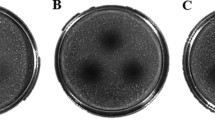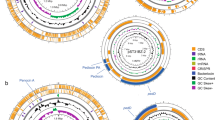Abstract
The probiotic strain Bacillus licheniformis MCC2514 has been shown to produce a strong antibacterial peptide and the whole genome sequence of this strain is also reported in our previous study. The present study is focused on the genome level investigation of this peptide antibiotic and its characterization. Genome mining of the culture revealed the presence of three putative bacteriocin clusters, viz. lichenicidin, sonorensin and lasso peptide. Hence, the mode of action of the peptide was investigated by reporter assay, scanning electron microscopy, and Fourier Transform Infrared spectroscopy. Additionally, the peptide treated groups of Kocuria rhizophila showed a reduction in the fold expression for transcription-related genes. The gene expression studies, quantitative β-galactosidase induction assay using the RNA stress reporter strain, yvgS along with the homology studies concluded that lasso peptide is responsible for the antibacterial activity of the peptide which acts as an inhibitor of RNA biosynthesis. Gene expression analysis showed a considerable increase in fold expression of lasso peptide genes at various fermentation hours. Also, the peptide was isolated, and its time-kill kinetics and minimum inhibitory concentration against the indicator pathogen K. rhizophila were examined. The peptide was also purified and the molecular weight was determined to be ~ 2 kDa. Our study suggests that this bacteriocin can function as an effective antibacterial agent in food products as well as in therapeutics as it contains lasso peptide, which inhibits the RNA biosynthesis.









Similar content being viewed by others
Data availability
All data generated or analysed during this study are available from the corresponding author on reasonable request.
References
Baquero F, Beis KJ, Craik D, Li Y, James Link A, Rebuffat S, Salomón R, Severinov K, Zirah S, Hegemann J (2024) The pearl jubilee of microcin J25: thirty years of research on an exceptional lasso peptide. Nat Prod Rep. https://doi.org/10.1039/D3NP00046J
Barbosa JC, Gonçalves S, MakowskiM SÍC, Caetano T, Schneider T, Mösker E, Süssmuth RD, Santos NC, Mendo S (2022) Insights into the mode of action of the two-peptide lantibiotic lichenicidin. Colloids Surf B 211:112308. https://doi.org/10.1016/j.colsurfb.2021.112308
Berić T, Stanković S, Draganić V, Kojić M, Lozo J, Fira D (2014) Novel antilisterial bacteriocin licheniocin 50.2 from Bacillus licheniformis VPS50.2 isolated from soil sample. J Appl Microbiol 116(3):502–510. https://doi.org/10.1111/jam.12393
Cotter PD, Ross RP, Hill C (2013) Bacteriocins—a viable alternative to antibiotics? Nat Rev Microbiol. https://doi.org/10.1038/nrmicro2937
Dindhoria K, Kumar S, Baliyan N, Raphel S, Halami PM, Kumar R (2022) Bacillus licheniformis MCC 2514 genome sequencing and functional annotation for providing genetic evidence for probiotic gut adhesion properties and its applicability as a bio-preservative agent. Gene 840:146744. https://doi.org/10.1016/j.gene.2022.146744
Goel A, Halami PM, Tamang JP (2020) Genome analysis of Lactobacillus plantarum isolated from some Indian fermented foods for bacteriocin production and probiotic marker genes. Front Microbiol. https://doi.org/10.3389/fmicb.2020.00040
Guo X, Chen J, Sun H, Luo L, Gu Y, Yi Y, Wang X, Shan Y, Liu B, Zhou Y, Lü X (2020) Mining, heterologous expression, purification and characterization of 14 novel bacteriocins from Lactobacillus rhamnosus LS-8. Int J Biol Macromol 164:2162–2176. https://doi.org/10.1016/j.ijbiomac.2020.08.067
Halami PM (2019) Sublichenin, a new subtilin-like lantibiotics of probiotic bacterium Bacillus licheniformis MCC 2512T with antibacterial activity. Microb Pathog 128:139–146. https://doi.org/10.1016/j.micpath.2018.12.044
Hegemann JD, Zimmermann M, Xie X, Marahiel MA (2015) Lasso peptides: an intriguing class of bacterial natural products. Acc Chem Res 48(7):1909–1919. https://doi.org/10.1021/acs.accounts.5b00156
Khabthani S, Rolain JM, Merhej V (2021) In silico/In vitro strategies leading to the discovery of new nonribosomal peptide and polyketide antibiotics active against human pathogens. Microorganisms. https://doi.org/10.3390/microorganisms9112297
Mercado V, Olmos J (2022) Bacteriocin production by Bacillus species: isolation, characterization, and application. Probiotics Antimicrob Proteins 14(6):1151–1169. https://doi.org/10.1007/s12602-022-09966-w
Miller JH (1972) Assay of β-galactosidase. Cold Spring Harbor Laboratory
Mingmongkolchai S, Panbangred W (2018) Bacillus probiotics: an alternative to antibiotics for livestock production. J Appl Microbiol 124(6):1334–1346. https://doi.org/10.1111/jam.13690
Pei J, Jin W, Abd El-Aty AM, Baranenko DA, Gou X, Zhang H, Geng J, Jiang L, Chen D, Yue T (2020) Isolation, purification, and structural identification of a new bacteriocin made by Lactobacillus plantarum found in conventional kombucha. Food Control 110:106923. https://doi.org/10.1016/j.foodcont.2019.106923
Powell JE, Witthuhn RC, Todorov SD, Dicks LMT (2007) Characterization of bacteriocin ST8KF produced by a kefir isolate Lactobacillus plantarum ST8KF. Int Dairy J 17(3):190–198. https://doi.org/10.1016/j.idairyj.2006.02.012
Riffel A, Medina LF, Stefani V, Santos RC, Bizani D, Brandelli A (2002) In vitro antimicrobial activity of a new series of 1,4-naphthoquinones. Braz J Med Biol 35:811–818. https://doi.org/10.1590/S0100-879X2002000700008
Rohith HS, Halami PM (2021a) The combined effect of potential probiotic Bacillus licheniformis MCC 2514 and Bifidobacterium breve NCIM 5671 towards anti-inflammatory activity on HT-29 cell lines. Probiotics Antimicrob Proteins. https://doi.org/10.1007/s12602-021-09851-y
Rohith HS, Halami PM (2021b) In vitro validation studies for adhesion factor and adhesion efficiency of probiotic Bacillus licheniformis MCC 2514 and Bifidobacterium breve NCIM 5671 on HT-29 cell lines. Arch Microbiol 203(6):2989–2998. https://doi.org/10.1007/s00203-021-02257-y
Rohith HS, Peddha MS, Halami PM (2023) Probiotic Bacillus licheniformis MCC2514 and Bifidobacterium breve NCIM 5671 regulates GATA3 and Foxp3 expression in the elevated disease condition. Probiotics Antimicrob Proteins. https://doi.org/10.1007/s12602-023-10080-8
Sheikh BA, Bhat BA, Mir MA (2022) Antimicrobial resistance: new insights and therapeutic implications. Appl Microbiol Biotechnol 106(19):6427–6440. https://doi.org/10.1007/s00253-022-12175-8
Shobharani P, Halami PM (2014) Cellular fatty acid profile and H+-ATPase activity to assess acid tolerance of Bacillus sp. For potential probiotic functional attributes. Appl Microbiol Biotechnol 98(21):9045–9058. https://doi.org/10.1007/s00253-014-5981-3
Shobharani P, Padmaja RJ, Halami PM (2015) Diversity in the antibacterial potential of probiotic cultures Bacillus licheniformis MCC2514 and Bacillus licheniformis MCC2512. Res Microbiol 166(6):546–554. https://doi.org/10.1016/j.resmic.2015.06.003
Singh VP (2018) Recent approaches in food bio-preservation—a review. Open Vet J. https://doi.org/10.4314/ovj.v8i1.16
Todorov SD, Rachman C, Fourrier A, Dicks LMT, Van Reenen CA, Prévost H, Dousset X (2011) Characterization of a bacteriocin produced by Lactobacillus sakei R1333 isolated from smoked salmon. Anaerobe 17(1):23–31. https://doi.org/10.1016/j.anaerobe.2010.01.004
Vadakedath N, Halami PM (2019) Characterization and mode of action of a potent bio-preservative from food-grade Bacillus licheniformis MCC 2016. Prep Biochem Biotechnol 49(4):334–343. https://doi.org/10.1080/10826068.2019.1566141
van Heel AJ, de Jong A, Song C, Viel JH, Kok J, Kuipers OP (2018) BAGEL4: a user-friendly web server to thoroughly mine RiPPs and bacteriocins. Nucleic Acids Res 46(W1):W278–W281. https://doi.org/10.1093/nar/gky383
Weber W, Fischli W, Hochuli E, Kupfer E, Weibel EK (1991) Anantin—a peptide antagonist of the atrial natriuretic factor (ANF). i. producing organism, fermentation, isolation and biological activity. J Antibiotics 44(2):164–171. https://doi.org/10.7164/antibiotics.44.164
Zhu Y, Zhou Q, Li P, Gu Q (2021) Purification, characterization, and mode of action of Paracin 54, a novel bacteriocin against Staphylococci. Appl Microbiol Biotechnol 105(18):6735–6748. https://doi.org/10.1007/s00253-021-11505-6
Funding
The research work was carried under a DST-funded project (Sanction no. EEQ/2016/000310), Department of Science and Technology, New Delhi.
Author information
Authors and Affiliations
Contributions
All authors contributed to the study conception and design. Steji Raphel contributed to the material preparation, data collection and analysis. The first draft of the manuscript was written by Steji Raphel. Prakash M. Halami commented on previous versions of the manuscript. All authors read and approved the final manuscript.
Corresponding author
Ethics declarations
Conflict of interest
The authors have no relevant financial or non-financial interests to disclose.
Ethical approval
This article does not contain any studies with human participants or animals performed by any of the authors.
Additional information
Communicated by Yusuf Akhter.
Publisher's Note
Springer Nature remains neutral with regard to jurisdictional claims in published maps and institutional affiliations.
Supplementary Information
Below is the link to the electronic supplementary material.
Rights and permissions
Springer Nature or its licensor (e.g. a society or other partner) holds exclusive rights to this article under a publishing agreement with the author(s) or other rightsholder(s); author self-archiving of the accepted manuscript version of this article is solely governed by the terms of such publishing agreement and applicable law.
About this article
Cite this article
Raphel, S., Halami, P.M. Genome mining of Bacillus licheniformis MCC2514 for the identification of lasso peptide biosynthetic gene cluster and its characterization. Arch Microbiol 206, 143 (2024). https://doi.org/10.1007/s00203-024-03877-w
Received:
Revised:
Accepted:
Published:
DOI: https://doi.org/10.1007/s00203-024-03877-w




